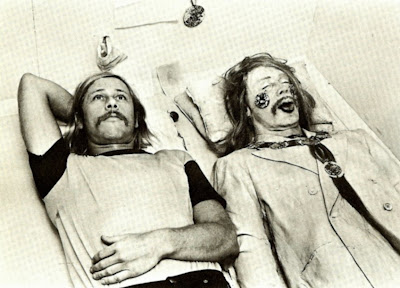Although Thek began as a painter, he became known later in life for his sculptures and installations. Notable works include Technological Reliquaries (1964-67), a series of wax sculptures of human body parts, and The Tomb, a bright pink pyramid installation or "environment", which was badly damaged in 1981 but is documented in Edwin Klein's black and white photographs. Thek died of AIDS related illness in New York City in 1988, aged 54.
http://en.wikipedia.org/wiki/Paul_Thek
In 1967, Paul Thek made one of the great, lost works in American art. The Tomb—Death of a Hippie was a large pink ziggurat containing a body cast of the artist attired in pink clothes and shoes. The tongue lolls from an opened mouth as in a swoon, the fingers of the right hand have been severed, and scattered around the body are offerings for the afterlife. The installation presented the artist as an eroticized, victimized vagabond; a creature shaped by Vietnam and Altamont, Kent State and Hair—a martyred hero for a new lost generation. In 1970, The Tomb came to Minneapolis in the Walker-organized exhibition Figures and Environments, which was installed in the auditorium of Dayton’s department store during construction of the Walker Art Center building. Years later, a badly damaged cast of the “hippie” was returned to Thek after an exhibition, but he refused to receive it; after storing it without pay, the shipper presumably destroyed it.
Richard Flood
http://www.walkerart.org/magazine/2005/an-artist-and-his-doppelgangers
 “The Tomb — Death of a Hippie,” became Thek’s most famous, and infamous,
piece: it consisted of a full-size cast of his body laid out as if
dead, surrounded by sacramental bowls and possible drug paraphernalia,
inside a pink wooden pyramid. Readings of the image have been endless:
it’s a symbol of the putrefying ideals of the 1960s; it’s a narcissistic
joke. Whatever its meaning, the piece now exists only in photographs.
“The Tomb — Death of a Hippie,” became Thek’s most famous, and infamous,
piece: it consisted of a full-size cast of his body laid out as if
dead, surrounded by sacramental bowls and possible drug paraphernalia,
inside a pink wooden pyramid. Readings of the image have been endless:
it’s a symbol of the putrefying ideals of the 1960s; it’s a narcissistic
joke. Whatever its meaning, the piece now exists only in photographs.Holland Cotter
http://www.nytimes.com/2010/10/22/arts/design/22thek.html?
Thek's most-discussed work was his sculptural installation The Tomb (1967), which chronologically and stylistically bridged his body-part relics and immersive environments. The Tomb consisted of a one-story-high, pale pink structure reminiscent of a Sumerian ziggurat, within which lay a full-size, painstakingly crafted effigy of Thek himself. Painted pale pink, the replicant featured long hair and a moustache like Thek's own, and wore a double-breasted suit and a necklace made of human hair, as well as other jewelry. Its tongue was sticking out of its mouth, and the fingers on its right hand- Thek's working hand-were cut off, leaving bloody stumps. The fingers hung inside a pouch near the figure. (The artist was thus symbolically "silenced," unable to do his work.) In the first presentation of The Tomb, at New York's Stable Gallery in 1967, Thek surrounded the figure with pink goblets, a funerary bowl, personal letters and some of his previous reliclike work, making The Tomb resemble an archeological dig. On the outside of the ziggurat, Thek posted a sign that detailed the structure's measurements, medium and fabricator, mocking the literalness of Minimalism while suggesting scientific precision. (The piece is now considered one of the great lost works of the 1960s. The figure disappeared after Thek refused to accept it from a shipping company in 1982, apparently because of damage the piece had incurred in transit.)
Matthew Israel
http://www.artinamericamagazine.com/features/finding-theks-tomb/2/
Thek visited the Palermo Catacombs in 1963 with Peter Hujar, who photographed much of the trip (a famous image from this trip depicts Thek’s encounter with the tomb and its remains). This experience led to him making works which imagine what the relics from his contemporary time would look like. Of which humans remains and their rather gory forms take centre stage. The work Tomb- Death of a Hippie(1967) is one of the most memorable pieces and for me a work of great significance and singularity for its time. The work comments on his generation’s loss of faith in the American Dream and any kind of innocence they may have felt prior to the Vietnam War. It also connects with the 50’s and 60’s obsession with popular culture, but it appears to highlight certain artists’ now rather tired use of ‘pop’ as a legitimate source for their work, and condemns them for becoming the very objects they originally parodied.
When viewing Thek’s work I am reminded of the very last scene in Easy Rider (1969). The Death of the Hippie pre-dates this film by a couple of years but as we hear Roger Mcguinn’s Ballad of Easy Rider play and the senselessness of the crime unfold, they both seem emblematic of the same questions. The plastic corpse of Thek’s remarkably sculpted Hippie is the remnants of his generation; an epitaph to ‘the summer of love’ and all the promise allied with western notions of ‘land of the free’. As Thek and Hujar found artefacts in the Palermo tomb belonging to a past civilization, the artist envisaged what such a tomb would look like from his own time.
Pipe
http://www.thisispipe.com/2011/04/discovering-paul-thek.html




No comments:
Post a Comment